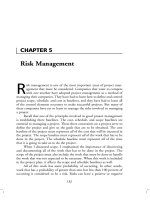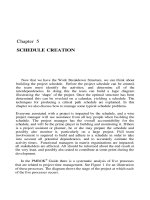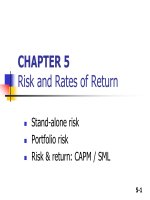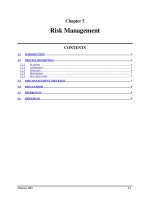Chapter 5 FacilitiesOperations Management - 5th EditionOperations Management - 5th Edition
Bạn đang xem bản rút gọn của tài liệu. Xem và tải ngay bản đầy đủ của tài liệu tại đây (467.29 KB, 47 trang )
Chapter 7
Facilities
Operations
Operations Management
Management -- 55thth Edition
Edition
Roberta Russell & Bernard W. Taylor, III
Copyright 2006 John Wiley & Sons, Inc.
Beni Asllani
University of Tennessee at Chattanooga
Lecture Outline
Basic Layouts
Designing Process Layouts
Designing Service Layouts
Designing Product Layouts
Hybrid Layouts
Copyright 2006 John Wiley & Sons, Inc.
7-2
Facility Layout
Arrangement of areas within a facility to:
Minimize material-handling
costs
Utilize space efficiently
Utilize labor efficiently
Eliminate bottlenecks
Facilitate communication and
interaction
Reduce manufacturing cycle
time
Reduce customer service time
Eliminate wasted or
redundant movement
Increase capacity
Facilitate entry, exit, and
placement of material, products,
and people
Incorporate safety and security
measures
Promote product and service
quality
Encourage proper maintenance
activities
Provide a visual control of
activities
Provide flexibility to adapt to
changing conditions
Copyright 2006 John Wiley & Sons, Inc.
7-3
BASIC LAYOUTS
Process layouts
group similar activities together
according to process or function they
perform
Product layouts
arrange activities in line according to
sequence of operations for a particular
product or service
Fixed-position layouts
are used for projects in which product
cannot be moved
Copyright 2006 John Wiley & Sons, Inc.
7-4
Process Layout in Services
Women’s
lingerie
Shoes
Housewares
Women’s
dresses
Cosmetics
and jewelry
Children’s
department
Women’s
sportswear
Entry and
display area
Men’s
department
Copyright 2006 John Wiley & Sons, Inc.
7-5
Manufacturing Process Layout
Lathe Department
L
L
L
L
L
L
L
L
L
L
Milling
Department
Drilling Department
M
M
D
D
D
D
M
M
D
D
D
D
G
G
G
P
G
G
G
P
Grinding
Department
Receiving and
Shipping
Copyright 2006 John Wiley & Sons, Inc.
Painting Department
A
A
Assembly
7-6
A
A Product Layout
In
Out
Copyright 2006 John Wiley & Sons, Inc.
7-7
Comparison of Product
and Process Layouts
Product
Description
Description
Type
Type of
of process
process
Sequential
arrangement of
activities
Continuous, mass
production, mainly
assembly
Product
Product
Demand
Demand
Volume
Volume
Equipment
Equipment
Process
Functional
grouping of
activities
Intermittent, job
shop, batch
production,
mainly fabrication
Standardized, made Varied, made to
to stock
order
Fluctuating
Stable
Low
High
General purpose
Special purpose
Copyright 2006 John Wiley & Sons, Inc.
7-8
Comparison of Product
and Process Layouts
Product
Workers
Workers
Inventory
Inventory
Limited skills
Low in-process, high
finished goods
Storage
Small
Storage space
Material
Material handling
handling Fixed path (conveyor)
Aisles
Narrow
Aisles
Scheduling
Part of balancing
Scheduling
Layout
Layout decision
decision Line balancing
Goal
Equalize work at each
Goal
station
Advantage
Efficiency
Advantage
Copyright 2006 John Wiley & Sons, Inc.
Process
Varied skills
High in-process, low
finished goods
Large
Variable path (forklift)
Wide
Dynamic
Machine location
Minimize material
handling cost
Flexibility
7-9
Fixed-Position Layouts
Typical of projects
Equipment, workers,
materials, other
resources brought to the
site
Highly skilled labor
Often low fixed
Typically high variable
costs
Copyright 2006 John Wiley & Sons, Inc.
7-10
Designing Process Layouts
Goal: minimize material handling costs
Block Diagramming
minimize nonadjacent loads
use when quantitative data is available
Relationship Diagramming
based on location preference between areas
use when quantitative data is not available
Copyright 2006 John Wiley & Sons, Inc.
7-11
Block Diagramming
STEPS
create load summary chart
quantity in which
calculate composite (two
material is normally
moved
way) movements
develop trial layouts
Nonadjacent load
minimizing number of
distance farther
nonadjacent loads
than the next block
Unit load
Copyright 2006 John Wiley & Sons, Inc.
7-12
Block Diagramming: Example
Load Summary Chart
1
4
2
3
FROM/TO
Department
5
1
2
3
4
5
—
Copyright 2006 John Wiley & Sons, Inc.
DEPARTMENT
1
2
—
3
100
—
60
4
50
200
—
100
50
7-13
5
50
40
—
50
60
Block Diagramming:
Example (cont.)
2
2
1
1
4
3
2
3
1
1
3
4
3
2
5
5
5
4
4
5
200 loads
150 loads
110 loads
100 loads
60 loads
50 loads
50 loads
40 loads
0 loads
0 loads
Nonadjacent Loads:
110+40=150
0
110
1
4
100
2
150
200
150 200
50 5050 40 60
110
50
60
3
5
5
40
Grid 2
1
Copyright 2006 John Wiley & Sons, Inc.
3
4
7-14
Block Diagramming:
Example (cont.)
(a) Initial block diagram
1
(b) Final block diagram
2
4
3
5
Copyright 2006 John Wiley & Sons, Inc.
1
2
3
4
5
7-15
Relationship Diagramming
Schematic diagram that
uses weighted lines to
denote location preference
Muther’s grid
format for displaying
manager preferences for
department locations
Copyright 2006 John Wiley & Sons, Inc.
7-16
Relationship AEA Absolutely
Absolutelynecessary
necessary
E Especially
Especiallyimportant
important
II Important
Diagramming: Example
Important
O Okay
Production
Offices
Stockroom
Shipping and
receiving
Locker room
O
UU
XX
O
U
A
U
O
A
O
U
O
I
X
O
Okay
Unimportant
Unimportant
Undesirable
Undesirable
E
U
A
Toolroom
Copyright 2006 John Wiley & Sons, Inc.
7-17
Relationship Diagrams: Example (cont.)
(a) Relationship diagram of original layout
Offices
Stockroom
Locker
room
Toolroom
Copyright 2006 John Wiley & Sons, Inc.
Shipping
and
receiving
Key: A
E
I
Production
O
U
X
7-18
Relationship Diagrams: Example (cont.)
(b) Relationship diagram of revised layout
Stockroom
Shipping
and
receiving
Offices
Toolroom
Production
Copyright 2006 John Wiley & Sons, Inc.
Locker
room
Key: A
E
I
O
U
X
7-19
Computerized layout
Solutions
CRAFT
Computerized Relative Allocation of Facilities
Technique
CORELAP
Computerized Relationship Layout Planning
PROMODEL and EXTEND
visual feedback
allow user to quickly test a variety of scenarios
Three-D modeling and CAD
integrated layout analysis
available in VisFactory and similar software
Copyright 2006 John Wiley & Sons, Inc.
7-20
Designing Service
Layouts
Must be both attractive and functional
Types
Free flow layouts
Grid layouts
encourage browsing, increase impulse purchasing, are flexible
and visually appealing
encourage customer familiarity, are low cost, easy to clean and
secure, and good for repeat customers
Loop and Spine layouts
both increase customer sightlines and exposure to products,
while encouraging customer to circulate through the entire
store
Copyright 2006 John Wiley & Sons, Inc.
7-21
Types of Store Layouts
Copyright 2006 John Wiley & Sons, Inc.
7-22
Designing Product
Layouts
Objective
Balance the assembly line
Line balancing
tries to equalize the amount of work at each
workstation
Precedence requirements
physical restrictions on the order in which operations
are performed
Cycle time
maximum amount of time a product is allowed to
spend at each workstation
Copyright 2006 John Wiley & Sons, Inc.
7-23
Cycle Time Example
Cd =
Cd =
production time available
desired units of output
(8 hours x 60 minutes / hour)
(120 units)
Cd =
480
120
= 4 minutes
Copyright 2006 John Wiley & Sons, Inc.
7-24
Flow Time vs Cycle Time
Cycle time = max time spent at any station
Flow time = time to complete all stations
1
2
3
4 minutes
4 minutes
4 minutes
Flow time = 4 + 4 + 4 = 12 minutes
Cycle time = max (4, 4, 4) = 4 minutes
Copyright 2006 John Wiley & Sons, Inc.
7-25









